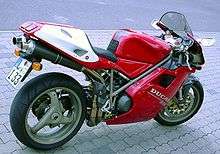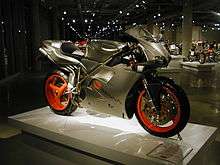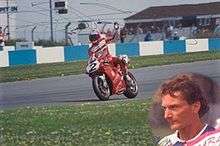Ducati 916
 1998 Ducati 916 SPS | |
| Manufacturer | Ducati |
|---|---|
| Production | 1994-1998 |
| Predecessor | Ducati 888 |
| Successor | Ducati 996 |
| Class | Sport bike |
| Engine | 916 cc (56 cu in), 90° V-twin, fuel injected 4-valve-per-cylinder desmodromic, liquid-cooled[1][2] |
| Top speed |
257 km/h (159.7 mph)[1] or 260 km/h (161.6 mph)[2] |
| Power | 85 kW (114 bhp) @ 9000 rpm (claimed)[1] |
| Torque | 67 lb⋅ft (91 N⋅m) @ 6,900 rpm (claimed)[3] |
| Transmission | 6-speed, chain drive[1] |
| Frame type | Tubular steel trellis frame[1] |
| Suspension |
Front: 43 mm (1.7 in) Showa Rear: Showa rising-rate mono swingarm (US and Senna had Öhlins)[2] |
| Brakes |
Front: Dual 320 mm (13 in)[2] disc Rear: Single 220 mm (8.7 in)[2] disc[1] |
| Wheelbase | 1,410 mm (56 in)[2] |
| Dimensions |
L: 2,050 mm (81 in)[2] W: 685 mm (27.0 in)[2] |
| Seat height | 790 mm (31 in)[2] |
| Weight |
194.5 kg (429 lb)[1] (dry) |
The Ducati 916 is a fully faired sport bike made by Ducati from 1994 to 1998.[lower-alpha 1] Featuring a 916 cc (56 cu in) fuel injected, 4-valve, desmo, liquid-cooled, 90° V-twin engine in a trellis frame with a single-sided swingarm and USD forks, the 916 is frequently cited as one of the most beautiful motorcycles ever.[5][6]
Design and development


The first development of the 916 model family can be traced back to the development of the four-valve Ducati engine, the Desmoquattro, through the development and racing of the earlier Pantah models, to the road-going 851 and 888 models.
The chief designer of Ducati motorcycles since the 1970s was Fabio Taglioni (1920–2001), who introduced the Pantah in 1979. The engine was updated in the 1990s in the SuperSport (SS) series and all modern Ducati engines are derivatives of the Pantah, which used its camshafts to both open and close the engine's valves, eliminating the usual valve closing springs, a system called 'desmodromic'. Taglioni, did not, however, have an interest in four-valve head engines, and so this was left to his successor.[lower-alpha 2] The eight-valve V-twin was the work of Taglioni's successor, Massimo Bordi.[8]
Designed by Massimo Tamburini and Sergio Robbiano and his team at the Cagiva Research Centre in San Marino,[9] the 916's water-cooled engine was a revision of that of its predecessor, the 888,[10] with larger displacement and a new engine management system. The greater displacement was accomplished by increasing the crankshaft stroke from 64 mm to 66 mm, keeping the same 94 mm bore size as the 888, resulting in a capacity of 916 cc. (By the time the 916 was introduced, the final 851/888 Corse engines had also had their bore sizes increased to 96 mm resulting in 'race only' capacities of 926 cc and 955 cc respectively.)
The 916 was a smaller motorcycle than the 888, with a chrome-moly trellis frame which was shared with the Ducati 748 in 1995 and beyond.[11] This was combined with striking new bodywork that featured aggressive lines. In contrast to Japanese inline four-cylinder competitors of the time, its V-twin engine produced less outright power, but a more even torque spread. The 916 model was replaced by the 996 model in 1999.[12]
Design of the Ducati 916 was a synthesis of form and function:
- The stylish single-sided swingarm was designed to make wheel changes faster during races.
- The underseat exhausts improve aerodynamic performance, and gave very clean lines. This feature was initially introduced on the Honda NR, and although Ducati was not the first, it has remained one of the trademark features of 916 line.
Journalist Kevin Ash suggested that although the 916 was "one of the most influential machines of the last twenty years", the design is actually derivative of the Honda NR750, with the shared elements of underseat exhaust, narrow waist, similar squared-off dual headlights, and single-sided swingarm holding a large-section rear tire.[13]
Reception
| “ | The really big news for 1994, however, was the arrival of the ground-breaking 916. This machine's engine size matched its code number and had been achieved by increasing the stroke of the 888 from 64 to 66 mm. ... This was the work of Massimo Tamburini, who has been described as one of the greatest motorcycle designers of the late 20th century – and with good cause. ... To many enthusiasts around the world, the 916 was not simply the latest superbike, but the best there had ever been. It set new standards of performance, handling, and braking, but also style and charisma. ... The 916 changed the face of sports bikes in a way that only the original Suzuki GSX-R750 had managed a decade earlier. | ” |
| — Mick Walker, Motorcycle: Evolution, Design, Passion[14] | ||
| “ | [W]ho could forget 1994 when Ducati stunned the world with the amazing 916? It was another Ducati-inspired revolution in the high-performance sports motorcycle category. With the 916, technology and style, performance and symmetry reached maximum levels. ... From the worlds most prestigious bike magazines, the 916 received the title 'Motorcycle of the year' and many other well-deserved compliments. | ” |
| — Mirco De Cet, The Complete Encyclopedia of Classic Motorcycles[15] | ||
Making its debut in 1994, the Ducati 916 was admired because of its new design and outstanding technical features. At the time of introduction, the 916 was recognized by winning "every magazine's Bike of the Year award for 1994",[16] and Ducati sold out its entire first year's production run in the United States before any had actually arrived there.[17]
916 Senna
First presented at the Bologna Motor Show in December 1994, the 916 Senna was a special edition to commemorate Formula 1 World Champion, Ayrton Senna, an avid Ducati enthusiast who endorsed its release shortly before his death in May 1994.[18] At the time, the project was facilitated by the fact that Claudio Castiglioni, Ducati's owner, was a personal friend of Senna's. In total, between 1995, 1998 and 2001, Ducati released three "Senna" editions and, in every instance, net proceeds were donated to the Instituto Ayrton Senna charity.
Racing

Ducati won 4 Superbike World Championships with the 916, in 1994–1996, and in 1998, with riders Carl Fogarty and Troy Corser. Fogarty won again in 1999, with 996 replacing the 916, and again in 2001 with Troy Bayliss on the 996. Ducati won the Manufacturer's Championship in all those years plus 2000.
| Year | Rider | Victories | Bike | Manufacturer's Championship |
|---|---|---|---|---|
| 1994 | Carl Fogarty | 11 | Ducati 916 | Ducati |
| 1995 | Carl Fogarty | 13 | Ducati 916 | Ducati |
| 1996 | Troy Corser | 7 | Ducati 916 | Ducati |
| 1998 | Carl Fogarty | 3 | Ducati 916 | Ducati |
| 1999 | Carl Fogarty | 11 | Ducati 996 | Ducati |
| 2000 | (Colin Edwards) | (7) | (Honda RC51) | Ducati |
| 2001 | Troy Bayliss | 6 | Ducati 996 | Ducati |
On March 1 and 2 in 1999, at the AHRMA Classic Days at Daytona International Speedway, Devin Battley rode a 1998 Ducati 916 to two victories. First, in the eight-lap Formula One class, and then in the Battle of the Twins Open class.[19]
Subsequent models and legacy
The 916 was later replaced by the 996 and 998 with similar design but revised engines and more power.[15][lower-alpha 3]
Massimo Tamburini went on to design the MV Agusta F4, the bike which is seen as his replacement for the 916 range, and it shares many similarities with the 916 especially in the tail section. Both of these Tamburini designs were featured in the Guggenheim Museum's 1998 The Art of the Motorcycle exhibit.[20]
Looking back over a decade after its introduction, it is regularly placed on top lists of important designs in motorcycle history by authorities like the Guggenheim Museum, Bennetts,[21] and Design Week;[22] and authors Ian Falloon,[23] Hugo Wilson,[24] and Margaret Henderson.[25] In a retrospective on the 1990s, Motorcyclist magazine simply stated, "1994: Ducati 916 debuts. Did anything else happen that year?"[26]
In addition to the Guggenheim exhibit noted above, an example is also held by the San Francisco Museum of Modern Art.[27]
Footnotes
- ↑ Only 4 1994-model year 916 Monopostos were produced in 1993. Production was in full in 1994, with 3,196 916s of all types produced, followed by 3,875 in 1995, only 2,896 in 1996, then 5,281 in 1997 and finally 2,755 in 1998, by which time production of the 996 had begun, for a total 916 run of 18,006.[4]
- ↑ "For almost 30 years, Fabio Taglioni's talent had set Ducati on its course. ... But the maestro chose largely to ignore the development potential inherent in four-valve cylinder heads, however. This was left to his successor, Massimo Bordi."—The Art of the Motorcycle[7]
- ↑ "Other features introduced on the 916 included a single-sided swing arm, patented adjustable steering, an exhaust system with twin mufflers exiting just underneath the seat, and one of the most distinctive styling jobs ever seen on two wheels."—The Art of the Motorcycle[7]
References
Notes
- 1 2 3 4 5 6 7 Brown 2004, p. 147.
- 1 2 3 4 5 6 7 8 9 Falloon 2004, p. 210.
- ↑ "Ducati 916 Road Test". Classic Bikes. July 29, 2012. Retrieved September 4, 2016.
- ↑ Falloon 2004, pp. 220–223.
- ↑ The most beautiful motorcycle
- ↑ Tribute to designer
- 1 2 Guggenheim 2001, p. 379.
- ↑ Thompson 1998, p. 80 "Back in Bologna, a young engineer named Massimo Bordi had donned the mantle of the retired Taglioni. He was at work on the engine that would power Ducati into whatever the future held for it. This was a new, eight-valve, liquid-cooled, fuel-injected engine -- the prototype of the 851 engine which became, after extensive development, the 916 engine. In the course of his engineering education, Bordi had submitted a thesis on just such an engine. This theoretical engine used the Ford-Cosworth DFV V-8 as its model."
- ↑ Brown 2004, p. 148 "... Cagiva quit grand prix racing amid rumors of financial trouble. ... Those problems would cause the delayed arrival of the bike that was the undoubted star of 1994. Ducati's 916 combined style, speed, and poise to stunning effect. Designed by former Bimota co-founder Massimo Tamburini and his small team at the Cagiva Research Center in San Marino, the 916 was a uniquely beautiful motorbike, from its sharp nose to the exhaust tailpipes poking beneath the seat."
- ↑ Motor Cycle News 2001.
- ↑ Thompson 1998, p. 85 "The 916, currently Ducati's sporting flagship, was an almost completely new motorcycle that reflected a significant rethink on the part of Massimo Tamburini, its designer. Tamburini made the bike much smaller than its predecessors, using a significantly revised 916 cc V-twin engine."
- ↑ Falloon 2004, pp. 207–221.
- ↑ Ash 2008.
- ↑ Walker 2006, p. 202.
- 1 2 De Cet 2001, p. 90.
- ↑ Sulthoni 2013.
- ↑ Brown 1995.
- ↑ Ducati (8 October 2013). "Ducati present "Senna" version of 1199 Panigale S exclusively in Brazil from June 2014 (press release)".
- ↑ Cycle News, Mar. 17, 1999
- ↑ Guggenheim 2001, pp. 379, 396.
- ↑ Bennetts 2014.
- ↑ Relph-Knight 2001 "The likes of the Ducati 916 or the Vincent Black Shadow are fabulous machines, representing the pinnacle of engineering or performance, or both..."
- ↑ Falloon 2012.
- ↑ Wilson 2002, p. 110 "The Ducati 916 is one of the best looking and most successful bikes ever built."
- ↑ Henderson 2007.
- ↑ Motorcyclist 2012.
- ↑ SFMOMA 2014.
Sources
- Brown, Stuart F. (February 1, 1995), "Purity of purpose. (Ducati 916)", Popular Science – via HighBeam (subscription required)
- Relph-Knight, Lynda (August 23, 2001), "Classics: which vehicles set the pulse of designers racing?", Design Week – via HighBeam (subscription required)
- Brown, Roland (2004), History of the Motorcycle: From the first motorized bicycles to the powerful and sophisticated superbikes of today, Bath, UK: Parragon Publishing, pp. 147–148, ISBN 978-1-4054-3952-7
- "The Nineties THE TURNAROUND YEARS", Ducati Heritage, Ducati Motor Holding, 2009
- "916 SBK Tech Spec", Ducati Heritage, Ducati Motor Holding, 2009
- De Cet, Mirco (2001), The Complete Encyclopedia of Classic Motorcycles: informative text with over 750 color photographs (3rd ed.), Rebo, ISBN 978-90-366-1497-9
- Falloon, Ian (2004), "916, 996, 998, and 748", Standard Catalog of Ducati Motorcycles 1946–2005, Iola, WI: KP Books, pp. 207–221, ISBN 978-0-87349-714-5
- Falloon, Ian; Taglioni, Fabio (FRW) (2006). The Ducati Story: Racing and Production Models from 1945 to Present Day (4th ed.). Haynes. ISBN 978-1-84425-322-7.
- Solomon R. Guggenheim Museum; Field Museum of Natural History; Museo Guggenheim Bilbao (2001), The Art of the Motorcycle, Guggenheim Museum, pp. 379, 396, ISBN 978-0-8109-6912-4
- Thompson, Jon F.; Bonnello, Joe (1998), Ducati, MotorBooks/MBI Publishing Company, p. 80, ISBN 978-0-7603-0389-4
- Walker, Mick (2006), Motorcycle: Evolution, Design, Passion, JHU Press, ISBN 978-0-8018-8530-3
- The evolution of the Ducati 996 engine, Motor Cycle News, July 15, 2001, retrieved 2014-04-06
- Ash, Kevin (December 12, 2008), Massimo Tamburini, archived from the original on September 6, 2013
- Falloon, Ian (March 6, 2012), "5 Greatest bikes - Ducati 916", Australian Motorcycle Trader, archived from the original on 2014-04-08, retrieved 2014-04-06
- Wilson, Hugo (2002), Hot Bikes, DK ADULT, ISBN 978-0789483966
- Henderson, Margaret (2007), "9. The best motorbike: The Ducati 916 Superbike", in Alan McKee, Beautiful Things in Popular Culture, Blackwell, p. 124, ISBN 9781405178556
- A Century of Motorcycling—The 1990s, Motorcyclist, September 18, 2012
- Sulthoni (July 3, 2013), 1996 Ducati 916 Biposto, Top Speed
- "Item 31463: Massimo Tamburini (Italian), Ducati Senna 916 Series III Motorcycle, 1997 — design object (metal, plastic, natural rubber, Kevlar, and paint)", Artwork collection database, San Francisco Museum of Modern Art, 1997, retrieved 2014-04-07
- Legendary Bikes, Bennetts, c. 2014, retrieved 2014-04-06
External links
| Wikimedia Commons has media related to Ducati 916. |
- Ducati 916 SBK at Ducati.com Heritage.